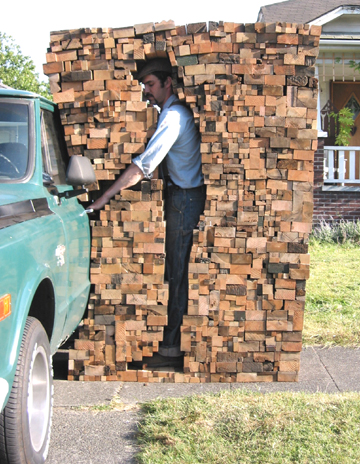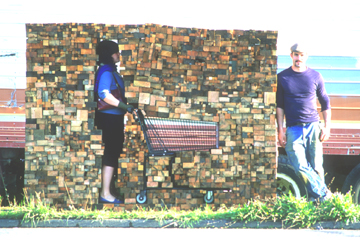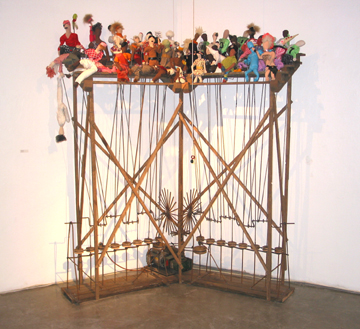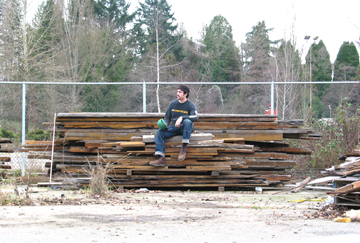Profile: David Rubin
By Raymond J. Steiner
ART TIMES April 2004
|
FOR THOSE WHO think that the marriage of science and art suffered final divorce after Leonardo da Vinci and the Italian Renaissance, welcome to the world of David Rubin. Now in the final months of earning his MFA from the University of Washington in Seattle, Washington, Rubin’s evolution from tinkering with whatever pieces of machinery he could find in and around the buildings scattered about the farm where he grew up to his present-day construction of acclaimed and award-winning sculptures seems, in retrospect, to have been a foregone conclusion.
Like a great many artists, his early days were spent in the exploration of drawing, of replicating three-dimensional objects on two-dimensional surfaces. He developed an early appreciation for traditions of art from his mother who not only filled their home with artbooks and art, but also took the time to take him on trips to museums. The influence took root. Like most budding boy artists, he filled his notebooks with drawings of autos and planes and even tried his hand at putting down likenesses of people.
It was objects themselves – their tangibility, their construction – however, that most often captivated his curiosity, his interest, and it was here that his stepfather exerted his influence. A building contractor, who knew his way around the tools and equipment of construction, he instilled in David an appreciation and first-hand knowledge of how and why things worked. Given free reign to take apart old farm implements and equipment to see how they were constructed would eventually result in his not only "putting back together," but also in creating his own mechanical conceptions. Today, a typical David Rubin sculpture – a combination of harmony and mechanics – reveals both strands of his raising. He readily acknowledges, "The background in art that I received from my mother and the practical knowledge I learned from my stepfather lie at the root of who and what I am today. All of my work," he says, "can be traced back to their support and influence."
 "Employed" |
Encouragement also came from teachers who, from early days in elementary school, recognized Rubin’s natural inclinations. From drawing and painting, he branched out into ceramics and woodturning, again finding the three-dimensional object a more compelling outlet for his talent. Conventional molding and carving soon lost its hold on him, the putting together of disparate parts into a unified whole a more compelling route for his widening range of interests. In time, pieces of wood, stone, steel and aluminum that struck his fancy presented more challenging ventures – how to combine them into never-before-seen forms? Whatever came across his path – an oddly shaped piece of metal or wood, a beautiful stone – became fodder for his inventive mind and capable hands.
Today – focussed, intense, articulate – Rubin, though his path into the realm of art was eminently practical and thoroughly grounded in the commonsense realm of day-to-day realities, has transferred the inquiring curiosity of his hands to the mental reaching out of his mind.
If the fertile groundwork of classical art and mechanics had been prepared by his parents, as he grew into manhood his own probing into the physics behind matter and energy became both the "stuff" of his art and the means he would exploit to explore his world. In high school and college his work became a process of problem solving by which he might realize his understanding of the dynamic relationship between matter and motion in sculptural works. Though the work of men like Buckminster Fuller and Alexander Calder drew his attention, he wanted not to duplicate their art but to transcend it – to make it into his own. Fuller’s concepts of stability and Calder’s sensitivity to motion were, for him, starting and not ending points. He wanted to construct pieces that would contain both stability and kinetic energy at one and the same time.
More often than not, in his early works at college, the process would begin with some found object that caught his eye – a tree stump, a piece of steel, a rock – and then a slowly evolving idea of what he might do with it. A natural consequence of the process would involve not only locating objects, but also discovering how to get them back to his studio. In the beginning, he would visualize his solution, then go about discovering the mechanics of how to combine wood, metal or stone to attain his vision. If construction involved techniques or tools or procedures beyond his means or control, he had to learn where to go to find his answers. Interactions with loggers, truckers, stonemasons, equipment operators – whoever – for either information or help – sometimes both – became just another step toward realizing a goal. If modest in scale in the beginning, pieces slowly got larger, heavier, and soon he began building a body of work that started to attract notice beyond the classroom. Before long, a signature Rubin sculpture became an apparently monolithic, static, construction that was in fact a work in which separate elements that would – often with the slight touch of a hand or a breath of wind – work off each other to release the dormant energy lying pregnantly and deceptively beneath a placidly imposing and seemingly unyielding surface.
 "Lipstick or Bacon" |
As his expertise grew in making matter conform to his will, so also did his artistic vision grow to include a wider context than the ding an sich – the thing in itself. If the resultant sculpture was the "answer" to a specific question that he posed himself, what became more of interest was the questioning itself. Thus, process – which had always been paramount (if not consciously apparent) ever since his days of taking apart things – began to supercede product. Consequently, in recent years – and in an effort to keep up with his maturing perspectives – Rubin began moving from the site-specific, "rooted" piece of sculpture to the more transient and transitory installation piece.
"Answers no longer interest me," says Rubin. "I am more interested in asking new questions." The fact that the installation pieces can not only be "broken down" and moved to other locations, but can also be transmuted into different configurations while maintaining an integrated "truth" in its initial make-up, allows for an open-ended and endless "questioning" and "answering" process to ensue.
A chance discovery of a huge stash of unused lumber at just this time had proven a boon to these latest endeavors. After talking the owners into letting him take the wood off their hands "free of charge" and hiring a trucker to get the boards to the college, he spent the greater part of six months to a year cutting them into manageable lengths, ending up with a king-size set of "building blocks" that would become perfect elements in a series of "put-together-take-down-and-rearrange-question-and-answer" installation works.
But even here, Rubin had already been framing those "questions" in a larger context — a context that took into consideration the ultimate enigma surrounding the human condition – and thus was born his latest explorations. The question became: How and why and where does the human fit into the process? His most recent work addresses just this theme, his sculptural installations including the presence of a living person (often himself) as an integral part of the work.
"In life, we are all in a context," he explains, "a context that is of our own making, one that is the result of all the choices we have made in the past." By placing himself in the actual work, Rubin is literally attempting to ascertain "where he is" in relation to his past actions (the choices and processes that went into the particular piece of sculpture) and to discover "how he got there."
 "That's Not A Toy" |
Several of these works (one, entitled "Lipstick or Bacon" in which a woman is pushing a shopping cart, while another, "Employed," has Rubin getting into his pickup) have, especially in the cases noted above, the person "embedded" in a surrounding construction of those pre-cut wood-pieces, the enclosure, in effect, locking the individual inside a sculpture that betrays no means of egress. Hence, just as is the sculptor himself, we are "trapped" in a context of our own making – rendering questions such as that of whether to seek the vanity of "lipstick" or "bringing home the bacon" posed by the woman pushing the shopping cart, purely rhetorical inasmuch as it is already doomed to a pre-determined conclusion, Like her – or like the sculptor – we exist in a "conclusion" that we have inescapably brought upon ourselves.
Presently putting the finishing touches on his master’s thesis – a work tentatively called "The American Dream" – Rubin has already left a considerable mark on the current artscene. With participation in at least 9 group shows since 2001, one solo show, about half a dozen award-winning sculptures, one commission under his belt and representation in the Permanent Sculpture Collection of Plattsburgh State University – in addition to teaching and curating shows – he is well on his way to becoming a major talent with which art historians and critics must someday contend.
For David Rubin – who simply wants his viewers to come away with a question of their own that might clarify their own paths – he wants merely to be left with more questions. Science might have brought him (and the world) to precisely this context, but it is art that still has the power to offer alternatives. Unlike a great many artists who have fallen into a time-tested, self-satisfying (or lucrative) formula, David Rubin, by remaining open to relevant questions, might just find his art on an ever-widening trajectory of awareness. Not a bad position for a serious artist to be in – this is an artist to keep an eye on.
(David Rubin can be reached at DaveRubin@hotmail.com)

